![]()
![]()
![]()
Use LEFT and RIGHT arrow keys to navigate between flashcards;
Use UP and DOWN arrow keys to flip the card;
H to show hint;
A reads text to speech;
64 Cards in this Set
- Front
- Back
|
What is bremsstrahlung radiation
|
Bremsstrahlung (braking) x-rays are produced when incident electrons interact with
nuclear electric fields, which slow them down (brake) and change their direction. |
|
|
What does bremsstralung radiation look like
|
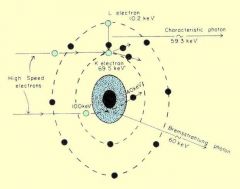
|
|
|
Schematic of a bremstruhlung radiation
|
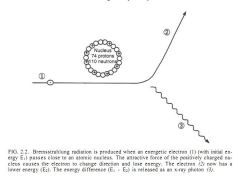
|
|
|
What does the bremsstrahlung spectrum look like
|
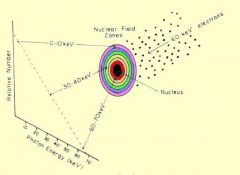
|
|
|
How is the energy of an xray determined from the bremsstrahlung radiation
|
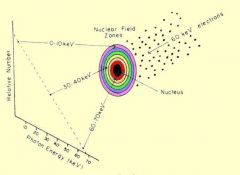
The closer the electron passes to the nucleus, the greater the interaction of the inci-
dent electron with the nucleus, and the higher the energy of the resulting x-ray. |
|
|
How does the realease of X-rays from characteristic X-ray work
|
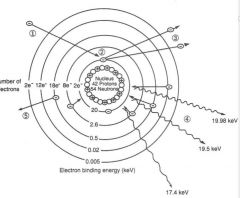
|
|
|
FIG. 2.3. Characteristic radiation is produced when an incoming electron (1) interacts with an
inner-shell electron (2) and both are ejected (3). When one of the outer-shell electrons moves to fill the inner-shell vacancy, the excess energy is emitted as characteristic radiation (4). Sometimes the excess energy is emitted as an Auger electron (5) rather than as characteristic radiation. |
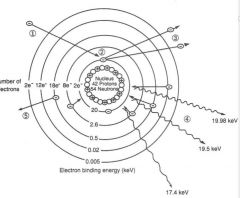
FIG. 2.3. Characteristic radiation is produced when an incoming electron (1) interacts with an
inner-shell electron (2) and both are ejected (3). When one of the outer-shell electrons moves to fill the inner-shell vacancy, the excess energy is emitted as characteristic radiation (4). Sometimes the excess energy is emitted as an Auger electron (5) rather than as characteristic radiation. |
|
|
What are characteristic X-rays
|

|
|
|
What does x-ray intensity refer to
|
Intensity refers to the quantity or number of x-ray photons produced.
|
|
|
Name 3 factors that affect x-ray intensity
|
-Intensity is affected by the generator type, beam filtration, and distance from the
beam (inverse square law). |
|
|
What percent of X-ray intensity is from characteristic radiation
|
10%
|
|
|
What is X-ray output proportional to
|
X-ray output is directly proportional to the current (mA), and to exposure time (sec-onds).
|
|
|
What is tube current and exposure time known as
|
Th e product of the tube current (mA) and exposure time (seconds) is known as the
mAs, and the x-ray tube output is proportional to the mAs. |
|
|
What are 2 ways of doubling the mAs
|
-Doubling the current at constant exposure time has the same effect as doubling the
exposure time at constant tube current. |
|
|
How does doubling the mAs effect the energy spectrum
|
Doubling the mAs doubles the number of x-rays emitted but does not change the
energy spectrum |
|
|
What happens to the quantity of x-rays produced when the kVp is increased
|
The quantity of x-rays produced can also be increased by increasing the kVp, but this also changes the quality or shape of the x-ray spectrum
|
|
|
Does increasing kVp increase the quantity
|
yes and will increase the energy
|
|
|
What is intensity synonomous with
|
quantity
|
|
|
What is increased by increasing the kVp
|
intensity (quantity) of x-rays
energy (increased quality) |
|
|
What is increased with increasing mAs
|
quantity (intensity)
|
|
|
What are 2 ways to increase the quantity (intensity)
|
increase mAs or kVp
|
|
|
Whe n the mA is increased and the
peak voltage and exposure time are constant, the intensity of the x-rays increases but the en-ergy distribution stays the same |
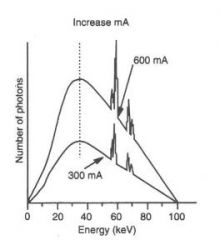
|
|
|
Whe n peak voltage is increased and the milliamperes and
exposure time are constant, the intensity, peak, and mean energy of the x-rays increase |
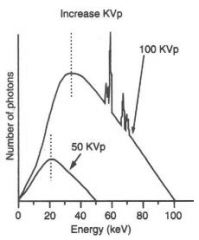
|
|
|
What is the tube potential proportional to
|
Th e quantity (intensity) of x-ray production is approximately proportional to the
square of the tube potential. |
|
|
What is meant by polychromatic X-rays
|
X-ray beams in diagnostic radiology are polychromatic and consist of a range of
photon energies |
|
|
What does the term quality X-rays mean
|
Quality refers to effective photon energy of the x-rays produced, and relates to their
ability to penetrate the patient. |
|
|
How is the quality of an X-ray beam obtained
|
Th e quality of an x-ray beam is obtained from the effective x-ray energy of the x-ray spectrum
|
|
|
What is the range of effective photon energy
|
Th e effective photon energy is taken to be between one third and one half of the
maximum photon energy. |
|
|
What does increasing the kVp do
|
Increasing the peak voltage (kVp) increases the x-ray tube output, peak energy,
and mean energy of the beam. |
|
|
What is kVp
|
peak voltage
|
|
|
What does increasing beam quality do to penetrating power
|
-Increasing beam quality increases x-ray beam penetrating power because the av-erage photon energy is higher.
|
|
|
What are the relative effects on film density between kVp and mAs
|
A rule of thumb is that increasing the peak voltage by 15% has the same effect on
film density as that of doubling the mAs. |
|
|
What does reducing the voltage waveform ripple do to the average photon energy
|
Reducing the voltage waveform ripple increases average photon energy and thus x-ray beam quality
|
|
|
What is ripple
|
A constant high voltage is desired across the x-ray tube for x-ray production, but in
practice, there is some variation in the voltage, which is called ripple. |
|
|
What does voltage ripple look like
|

|
|
|
What does a X-ray tube look like
|
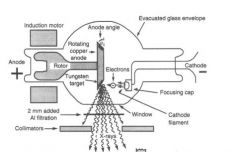
|
|
|
What is this image demonstrating
|
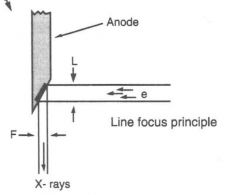
The magnified view of the target illustrates the line focus principle, whereby
the focal spot size (F) is smaller than the electron beam (L) because of the anode angle. |
|
|
What is the electron source of the x-ray tube
|
X-ray tubes contain a negatively charged cathode containing the filament that
serves as an electron source. |
|
|
Where are the X-rays produced in the X-ray tube
|
Th e anode is positively charged and includes the target where x-rays are produced.
|
|
|
Why is the x-ray tube in an evacuated envelope
|
Th e anode and cathode are contained in an evacuated envelope to prevent the elec-trons from colliding with gas molecules.
|
|
|
What is the function of the X-ray tube housing
|
Th e envelope is contained in a tube housing that protects and insulates the tube and
provides shielding to prevent leakage radiation. |
|
|
What part of the tube housing helps in cooling
|
Th e housing contains an oil bath to provide electrical insulation and help cool the
tube. |
|
|
What are anodes made of
|
tungsten
|
|
|
Do some anodes have 2 focal spot sizes
|
yes
|
|
|
What is a focusing cap
|
A focusing cup or cathode block surrounds the filament and helps direct the elec-trons toward the target.
|
|
|
What does a focusing cap look like
|
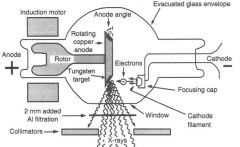
|
|
|
What does expulsion of electrons from the cathode look like
|
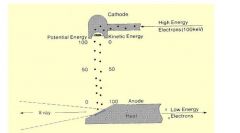
|
|
|
What causes electrons to be released by the cathode filament
|
Electrons that flow through electrical circuits cannot generally escape from the conductor material and move into free space. They can, however, if they are given sufficient energy. In a process known as thermionic emission, thermal energy (or heat) is used to expel the electrons from the cathode. The filament of the cathode is heated in the same way as a light bulb filament by passing a current through it. This heating current is not the same as the current flowing through the x-ray tube (the MA) that produces the x-radiation. During tube operation, the cathode is heated to a glowing temperature, and the heat energy expels some of the electrons from the cathode.
|
|
|
What causes the temperature to increase in the cathode
|
Th e high resistance in the filament causes temperature to rise (>2200°C), resulting
in the thermionic emission of electrons. |
|
|
What is the negative cloud surrounding the cathode called
|
Electrons emitted from a heated filament form a negative cloud around the filament
called a space charge, which prevents further emission of electrons. |
|
|
What is the tube current
|
Electrons emitted from a heated filament form a negative cloud around the filament
called a space charge, which prevents further emission of electrons. |
|
|
What is the range of tube current
|
Tub e current is in the range of 1 to 1,000 mA.
|
|
|
What occurs to the cathode at low peak voltage
|
A t low peak voltage, the potential is insufficient to cause all the electrons to be pulled
away from the filament, and a residual space charge remains (space charge limited operation). |
|
|
What occurs a saturation voltage
|
A t the saturation voltage, all electrons are immediately pulled away from the fil-ament, and the tube current is maximized.
|
|
|
What is the high voltage created by the generator used for
|
to accelarate the electrons as they move from the cathode to the anode
|
|
|
What is the typical voltage across the cathode filament itself (different then previous)
|
Typical voltages across the x-ray tube filament are 10 V, and currents through
the cathode filament are 4 A. |
|
|
How much power is dissipated by the cathode filament
|
Th e power dissipated from the filament (I x V) is typically 40 W
|
|
|
What does the x-ray tube and generator working in tandem look like
|
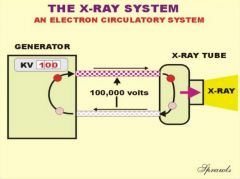
|
|
|
What do characteristic lines look like on an X-ray spectra
|
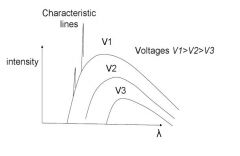
|
|
|
If the kVp is low do we see characteristic lines
|
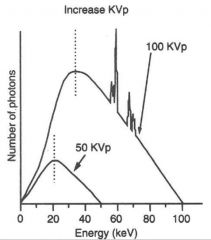
no
|
|
|
If the kVp is low do we see characteristic lines
|

no
|
|
|
What is the voltage waveform chart
|
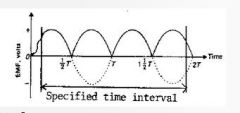
|
|
|
How is peak voltage demonstrated
|
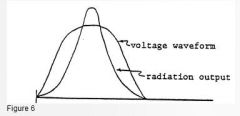
not that more x-rays are produced at peak voltage
|
|
|
In an X-ray tube how is Voltage and kVp and keV related
|

In the x-ray tube, electrons are generated at the filament end of the x-ray tube by thermionic emission (boiling of electrons from the filament). They are then given kinetic energy by applying a high voltage between the filament and the target. If a voltage of 100,000 volts (100 kVp) is applied to the x-ray tube, the electrons will strike the target producing x-rays with energies from 0 to 100 keV. Note: kVp is the voltage applied to the x-ray tube and keV is the energy of the x-ray. The low energy x-rays can not get out of the x-ray tube so the actual spectrum of x-rays range from about 10 keV to 100 keV. The higher the x-ray energy, the higher its ability to penetrate tissue. As the kVp increase so does the intensity of the x-ray beam, i.e. more x-rays of all energies are generated. (ignore picture)
|

